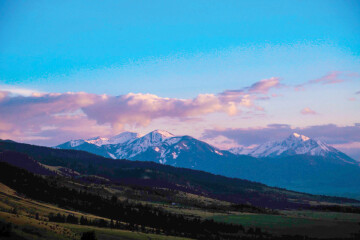Blueprint in Bozeman
As far as my understanding on homelessness went, my knowledge on the issue wasn’t as full as it is now. I grew up in Connecticut, which has the greatest “achievement gap” in the country. To be frank, Connecticut’s obstinate “achievement gap” is due mostly in part to the segregation of the affluent and non-affluent. Many efforts have been made to close this gap, focused mainly on merging students of color and low-income students with their white counterparts in neighboring districts. Due to institutional favoritism, students of color are unable to receive the advantages a white student will, and all of this was known growing up but rarely spoken aloud. It was a common understanding to have, and a damning one at that. Median household income in one area in Connecticut will come out at roughly $150,000 - $200,000 a year while the town twenty minutes over the mountain plummets to only $30,000 a year. Despite my high school’s effort to bring students from Hartford into our school district, it was essentially impossible to amalgamate those students into the social groups due to placement levels. Division was still possible with most of the incoming students from Hartford being kept in lower-level classes; social life where I lived was particularly nasty in general, which didn’t make it easier. Competition was praised and so was status and eligibility.
During my sophomore year, a friend and I made the journey into Hartford for the first time, accompanied of course, by my dad. (You could definitely say that we were kept inside a very reinforced bubble.) For a humanities project, we set out to volunteer at a homeless shelter known as the South Park Inn whose “mission is to help people who are homeless to improve their lives by providing temporary and long-term housing and supportive services” (SouthParkInn.org) Driving down the infamous Asylum Avenue, I remember being completely perplexed by what I was seeing. There was actual graffiti covering the buildings, wooden boards covering the windows and front doors of homes; nobody mowing the grass, nobody laying down fresh but dozens making a lines at the corner bus stops. Once we arrived, the shelter was full, and we were given a tour of the entire facility. This was now my idea of homelessness and the experience set up my expectation for how it would look for everyone else experiencing homelessness, aside from what you would find on the streets in New York. Little did I know, I was given just one example of what homelessness looks like.
The understanding I had of homelessness was too far removed from my daily life that I was able to put it away and not have it be something I thought about, ever. For me, at fifteen, that was something that happened to people “over the mountain,” as sadistic and ignorant as that sounds, but that’s the truth. Everyone I grew up with had everything at their disposal and Ivy League schools seemed to be the only set of choices. Clothes weren’t something people needed but had an unnecessary profusion of; several of my friends have never had to shop at a big-box store in their lives. In fact, we had to leave our town’s boundaries if we wanted a sliver of actual fast food. I never questioned my place in the world because I was blessed to have what I did and took everything for granted. The sense of guilt is overwhelming once you consider other perspectives on homelessness. It doesn’t always fit the stereotype with a cardboard sign and it’s essential to be mindful of that.
On the evening of November 7, 2019, I was fortunate enough to participate in the celebration of Blueprint’s five-year establishment in Bozeman, Montana. The non-profit, under HRDC, a non-profit community action agency dedicated to helping people and building a better community, houses homeless youth in the Gallatin Valley. Their obstinate continuance to serving our city’s youth is both powerful and effective, making a difference in the lives of teens amidst challenging circumstances. In response to youth who have been brought up in the foster system, left homeless due to their LGBTQ status or otherwise, and resorted to couch-surfing, Blueprint offers stable and safe housing, week-long case management (offering emotion, career, and education support) and support in the development of independent living skills. They believe that everyone deserves a safe place to call home and with that being made clear, the Equal Housing Opportunity comes into effect.
HRDC strives to build a better community. In November 2015, Blueprint program was opened with the intention of creating a paradigm shift in serving youth experiencing homelessness; currently, they house about 18 youth. According to the HRDC website, it’s their belief that supporting access to a safe living environment, education and employment are paramount for lasting success. By using art as a form of expression, some who found refuge and sanctuary at Blueprint along with staff, presented beautiful pieces for the gathering with personal testimonials attached. Youth Case Manager Helena Mancey wrote, “To me, flowers represent resilience and the cyclical nature of seasons. A flower’s ability, like Blueprint youth, to come back and display beauty and strength after a harsh season is inspiring. At Blueprint, I am continually amazed by the resilience of the clients and consider it an honor to come alongside them as they grow into their bright future.” Another Blueprint Home Manager, Katrina Fife wrote, “Pineapples are a symbol of hospitality. It used to be that pineapples were rare and hard to come by so if a pineapple was served, it was an extravagant affair. Like pineapples were, genuine hospitality is rare. So, I chose these pineapples to represent our value at Blueprint of being welcoming and inclusive of all people.”
Community partner HAVEN supports the education and facilitation of Blueprint groups. Abbie Bandstra supports Blueprint by leading a safe and inclusive space for healthy relationships and communication, LGTBQ rights, pro-social behaviors, and other topics. For Blueprint, she is a “truly energetic and thoughtful supportive adult” in the youth’s lives. Because of the tireless work that those at Blueprint have put into serving Bozeman’s youth, 73% of youth have gained employment, 53% have access to mental health services, 40% of youth have been in high school and 40% have obtained ownership of transportation means. Blueprint is funded solely by private donations from the community, and if you’re looking to encourage and do someone a substantial service, you can donate today at: https://thehrdc.org/give-now.

